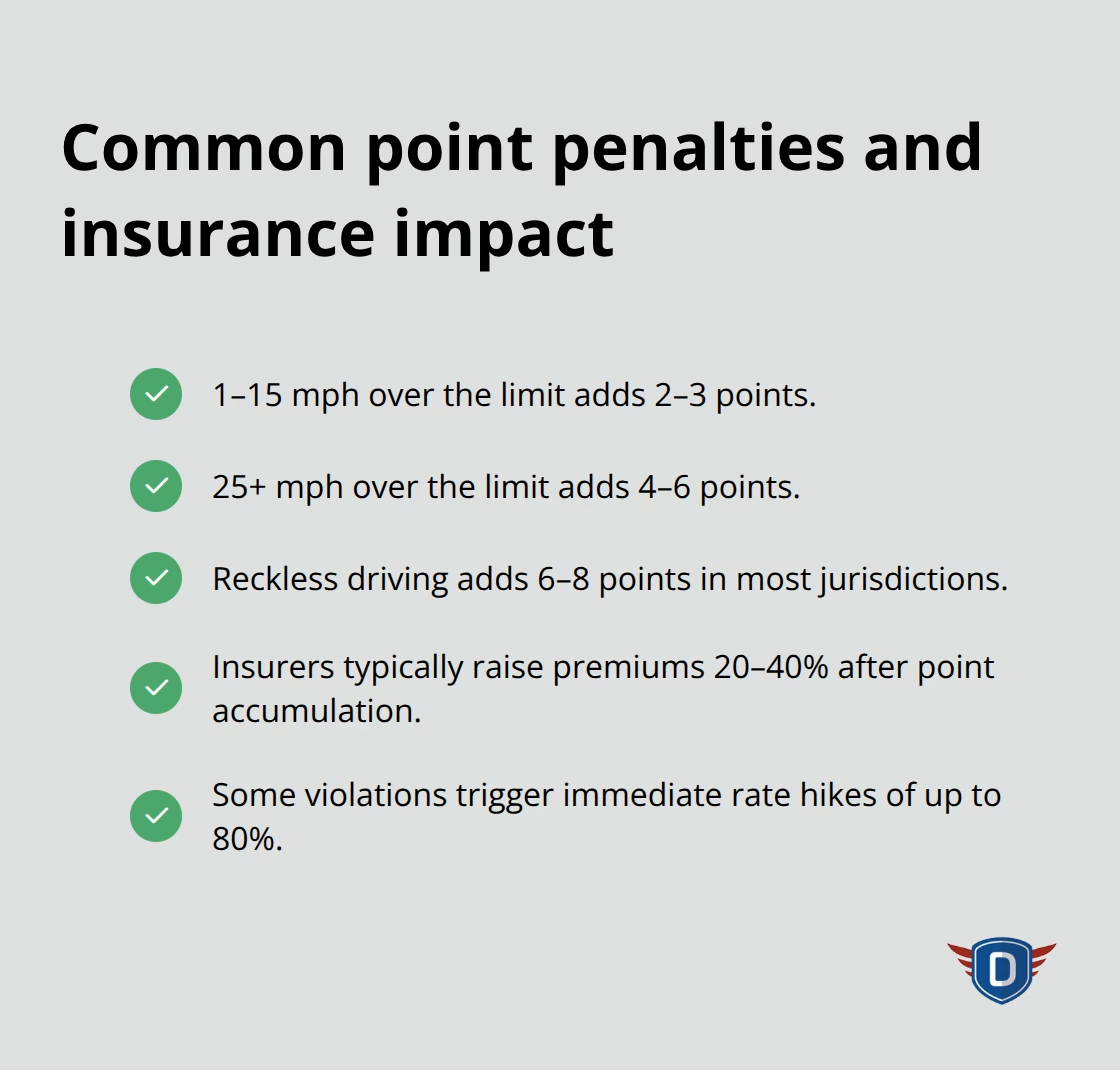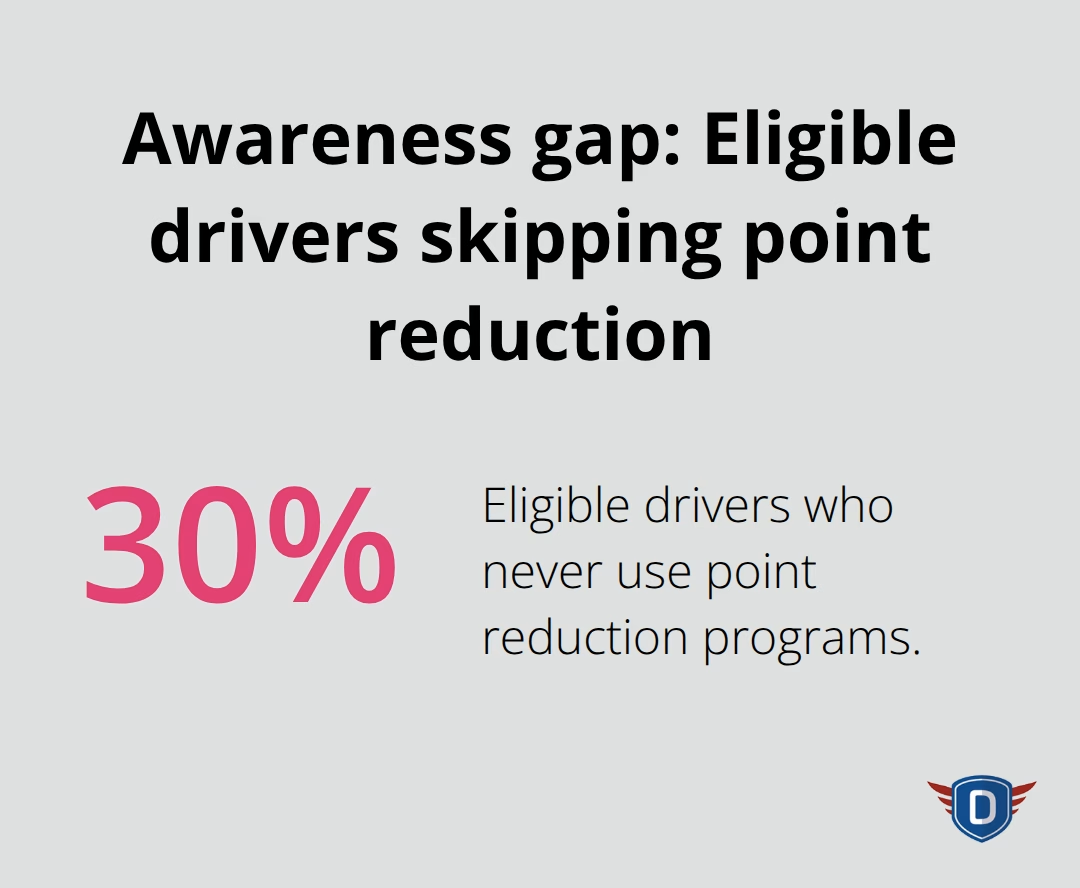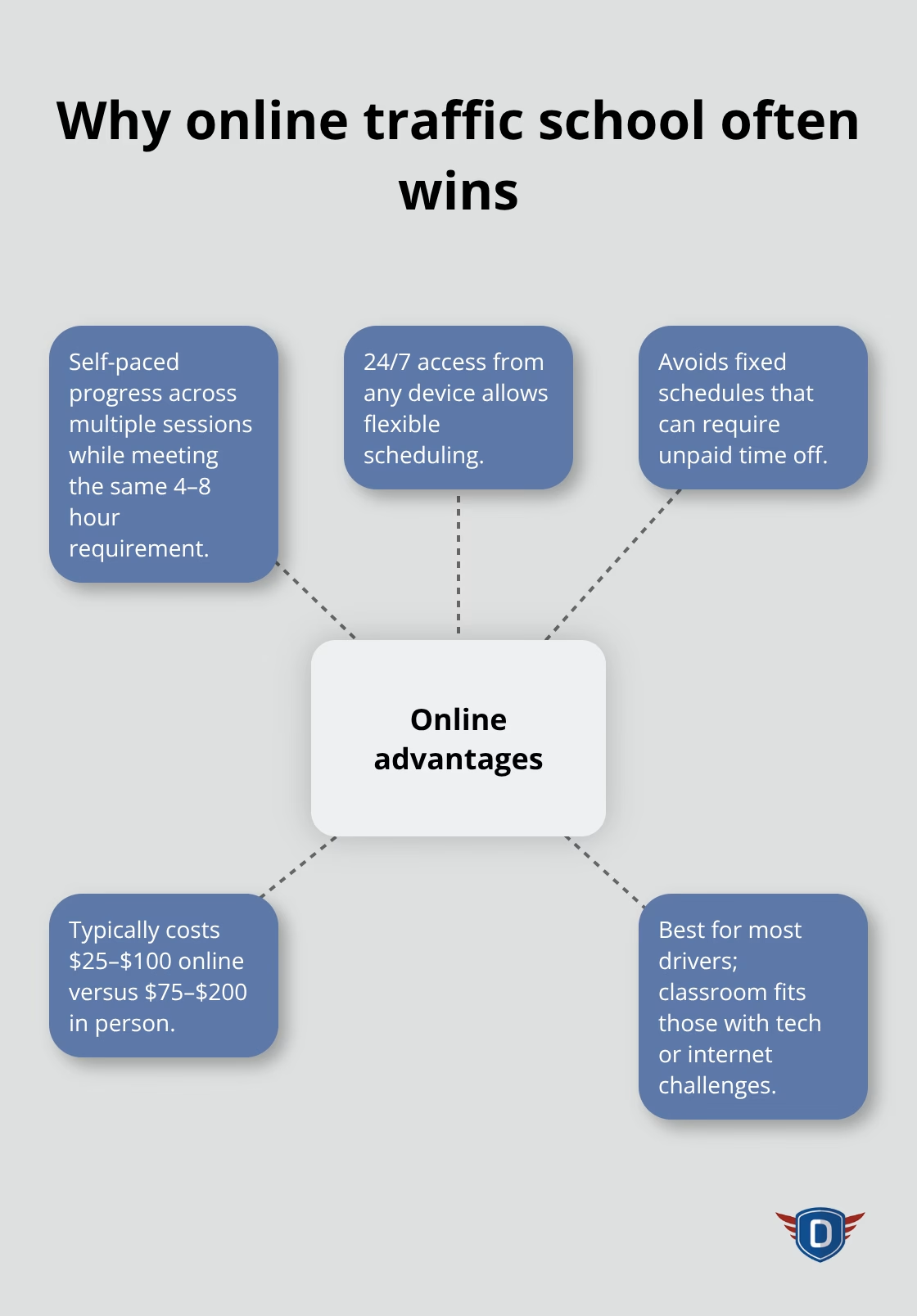Getting points on your driving record can lead to license suspension and skyrocketing insurance premiums. Traffic school for point reduction offers a proven solution to remove violations from your record.
We at floridadetscourse.com have helped thousands of drivers navigate state requirements and choose the right programs. This guide covers everything you need to know about reducing points through traffic school in 2025.
How Traffic School Point Reduction Works
Traffic violations add specific point values to your driving record based on the severity of the offense. Speeding typically adds 3-5 points nationwide, while red light violations add 3-4 points in most states. Young drivers face significantly higher crash risks, with drivers 16 to 19 years old involved in 4.8 fatal crashes per 100 million travel miles, compared to 3.3 for drivers 20 to 24, and 2.3 for drivers 25 to 29.
Point Values and Common Violations
Most states follow similar point structures for standard violations. Speeding 1-15 mph over the limit typically adds 2-3 points, while excessive speeding over 25 mph can add 4-6 points. Reckless driving violations carry the heaviest penalties at 6-8 points in most jurisdictions. Insurance companies access these records and typically increase premiums by 20-40% after point accumulation, with some violations that trigger immediate rate hikes of up to 80%.

State Requirements and Eligibility Rules
Eligibility for point reduction through traffic school varies dramatically by state. California allows point masking for eligible drivers once every 18 months, while Florida permits point reduction every 12 months for drivers with clean recent records. Most states require completion within 60-90 days of violation or court order. Texas and New York have the strictest requirements (they limit traffic school to first-time offenders or drivers with minimal violation history). Approximately 30% of eligible drivers never take advantage of point reduction programs due to lack of awareness about state-specific requirements and deadlines.

Program Variations Across States
Online traffic school completion removes 2-4 points in Ohio and reduces points by up to 3 in Missouri, which requires minimum 8-hour courses. Nebraska mandates 8 hours of instruction to remove exactly 2 points, while Virginia allows point reduction through approved driver improvement clinics. States like Illinois only offer insurance discounts rather than actual point removal. Course costs range from $25 in budget programs to $150 for comprehensive state-approved options, with completion times that vary from 4-8 hours based on state mandates (completion requirements differ significantly between jurisdictions).
Traffic school provides clear benefits beyond simple point reduction, which makes the investment worthwhile for most drivers.
Benefits of Traffic School Point Reduction
Traffic school completion prevents license suspension in states with accumulating point thresholds. California suspends licenses after 4 points in 12 months, while New York triggers suspension at 11 points within 18 months. Insurance companies increase premiums by 20-40% after point accumulation, with some violations that trigger immediate rate hikes up to 80%. Traffic school completion can help reduce insurance costs, which makes the $25-150 course cost a smart financial decision.
Avoiding License Suspension Costs
License suspension costs drivers an average of $10,000 in lost wages, alternative transportation, and reinstatement fees according to the American Association of Motor Vehicle Administrators. Point accumulation creates compound financial penalties beyond initial fines. Drivers with 3-4 points face insurance increases of $300-800 annually, while those who approach suspension thresholds see premiums double or triple. Traffic school completion masks violations in California and removes points entirely in states like Ohio and Missouri.
Insurance Premium Reductions
The National Highway Traffic Safety Administration confirms that traffic school reduces recidivism rates among drivers, which prevents future violations and associated costs. Court-ordered programs typically cost more than voluntary enrollment, with mandatory courses that range $100-200 compared to $25-75 for proactive completion. Many insurance companies provide additional discounts for drivers who complete approved traffic school courses (beyond the standard point reduction benefits).
Knowledge Updates and Safety Benefits
Traffic laws change frequently, with most drivers unaware of recent updates to speed limits, cell phone restrictions, and right-of-way rules. Traffic school courses cover current regulations and defensive techniques that reduce accident risk by 15-20% according to NHTSA studies. Online programs offer interactive elements with videos and quizzes that improve retention rates compared to traditional classroom instruction. Drivers who complete voluntary traffic school demonstrate commitment to safe practices, which some courts consider during future violations.
First-Time Offender Programs
States like Florida and Texas offer first-time offender programs that waive penalties entirely when completed within specified timeframes. These programs provide maximum value for eligible drivers who act quickly after violations. The selection of the right traffic school program becomes essential to maximize these benefits and meet state requirements.
Choosing the Right Traffic School Program
Online traffic school dominates the market with most students choosing digital programs over classroom instruction. Online courses cost $25-100 compared to $75-200 for in-person options, while they offer 24/7 access from any device. The completion time remains identical at 4-8 hours based on state requirements, but online programs allow self-paced progress over multiple sessions. In-person classes require fixed schedules that often conflict with work obligations and force drivers to take unpaid time off. Only drivers who struggle with technology or lack reliable internet should consider classroom alternatives.

State Approval Verification Methods
Every state maintains official lists of approved traffic school providers on their Department of Motor Vehicles websites. California requires court approval before enrollment, while Florida automatically accepts all state-licensed programs. Never enroll without you confirm approval status first – unapproved courses waste money and fail to reduce points. Check the school’s license number against your state’s database rather than trust website claims. Texas has the most restrictive approval process with only 12 certified providers statewide, while states like Ohio accept dozens of programs. Contact your court clerk directly if you remain unclear about specific program acceptance for your violation.
Program Cost Analysis and Time Requirements
Budget programs like 5 Dollar Traffic School offer courses for $5 with over 1 million satisfied customers and 4.9-star ratings from 14,000 reviews. Premium programs charge $100-150 but provide identical point reduction benefits. The National Highway Traffic Safety Administration confirms that course effectiveness depends on state curriculum requirements, not price. Most online programs include open-book exams with unlimited retakes, while expensive options add features like audio narration that provide minimal value. Complete courses early in your insurance renewal period to maximize premium savings (this strategy helps you capture the full benefit of point reduction). Mobile-friendly platforms allow completion during commutes or lunch breaks, which makes time investment more manageable than traditional classroom attendance.
Quality Indicators and Customer Reviews
Customer reviews on platforms like Trustpilot reveal significant differences between providers despite similar course content. Programs with completion rates above 95% typically offer better user interfaces and technical support. Look for schools that provide instant grading and immediate results after final exams (rather than programs that delay certificate processing). U.S.-based technical support teams available 24/7 indicate higher service quality compared to overseas call centers. Schools that offer 100% money-back guarantees demonstrate confidence in their programs and protect students from technical issues or dissatisfaction.
Final Thoughts
Traffic school for point reduction demands swift action after you receive a violation. You must verify your eligibility through your state’s DMV website within 30 days of the citation. Select a state-approved program that matches your budget and schedule, then complete the course before your deadline to prevent license suspension and insurance premium increases.
Point reduction delivers substantial financial benefits that exceed the initial course cost. Drivers who complete traffic school save $500-1,200 annually on insurance premiums while they avoid the $10,000 expense of license suspension. Clean records also qualify you for preferred insurance rates and employment opportunities that require safe drivers (positions in delivery, transportation, and sales often mandate clean records).
Start your enrollment process today and research approved programs in your state. We at floridadetscourse.com offer driver education programs that help students develop safe habits. Contact your court clerk if you need clarification about specific requirements, then complete your chosen program well before the deadline.

![Traffic School for Point Reduction [2025 Guide]](https://floridadetscourse.com/wp-content/uploads/emplibot/traffic-school-for-point-reduction-hero-1762312180.avif)





